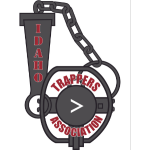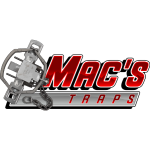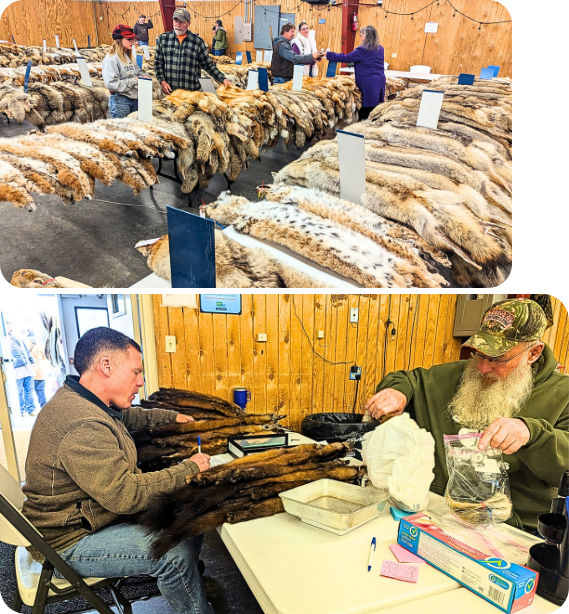Western States Fur Auction




It's what happens

FRI: Noon - 7p
SAT: 8a - 1p
SAT: 5p
MTA Members: 6%
Non-Members: 8%
No Sale: 2%

TBA

Montana Trappers Association


Camping is only available to those who are staying in association with an event being held at the Park County Fairgrounds or needing to stay at the Fairgrounds while conducting agricultural related activities and business. Bathroom facilities and showers onsite.

Coordinator
Brian Stoner
Co-Coordinator
Chris Morgan
Vendors
Ed Hebbe IV
Demonstrations
Guy Kempthorne
By Toby Trigger
At state fur sales trappers may place minimums on their fur. If the minimums are not met the trapper takes his fur back and may market it at some other venue. For example, a blanket beaver pelt is a pelt that measures over 65”, a measurement taken by measuring the length and width of the beaver pelt and adding the two values together. A beaver pelt which measures between 65 and 70 inches is called a “blanket”, if it is greater than 70 inches it is called a “super blanket”. If a trapper brings 10 blanket beaver pelts, to a state fur sale, they may place a minimum bid on that lot of $25.00 each or $250.00 for an overall average of $25.00.
As more and more trappers check fur into the sale registry, the fur is sorted, tagged with the fur sales tag and placed on grading tables in stacks according to the trappers registered lots. The tables fill with pelts arranged by species and lot designation. Pelts in the sale are differentiated by basic type. “Grease fur” is just as it sounds. Beaver, muskrat, mink, raccoon and otter are classified as such due to these pelts propensity to “weep” fats. Other furs are Coyote, fox, bobcat, marten, fisher and wolverine which do not readily leach fats. The skin side of grease furs take on a shiny appearance and diligent trappers constantly wipe the grease off and rub sawdust into the hide to keep the fat from matting the fur or worse yet, causing “grease burns”. Furs are stacked in a manner to keep the fur side touching fur side and skin side touching skin side. Good trappers take an extreme level of pride in their fur handling and usually, the most diligent trappers are compensated for their efforts.
If a Fur buyer doesn’t have to clean grease out of the fur, comb and trim the pelt before delivery to his primary buyer, that is one less step in his busy trap buying process that he can eliminate, so buyers pay more for the decreased work involved in marketing their fur. More money is lost due to improperly handled fur than any other reason.
Trappers are required to have their fur checked in by a specified time and then the registered fur buyers are the only people allowed to approach the tables. At the Montana state fur sale held in 2012, eight wild fur buyers made their way around the tables stacked with fur. It is quite a sight to watch fur buyers look over pelts, lifting each one, brushing the hair back with their hands, all the while writing down and shaking the furs. They listen for the crinkly sound of fat free, well-handled fur and sniff for the tell-tale aromas of poorly dried ears. Fur quality is assessed based on thickness, color, length of guard hairs and other factors as well. The general appearance of the furs consistency of preparation can go a long way in increasing the prices offered for any individual lot. Good fur-handlers get better prices.
After examining a single lot of fur, buyers write down numbers just as country buyers do. Then they go to the next lot and repeat. This goes on for several hours until the allotted time is up. Although there are many formats used at fur sales, the Montana Trappers Association has recently adopted a sealed bid process where buyers had to submit their bids in a sealed envelope. The highest bidder gets the fur, provided that they met the sellers minimum bid requirements. The total sales are tallied and when the buyer’s checks clear, the state association organizers begin writing checks to each trapper – minus the commission of about 6-11% depending on the sale.
Along with the fur check is a slip that shows the trapper who bought his fur, how much the buyer paid for each lot and the commission removed from the check. State sales allow the trapper to refuse or accept the offer and have other benefits. Trappers are paid quickly for their sale. Not as quickly as selling to a country buyer, but often the prices paid are much higher because there are more buyers vying for the fur. The more buyers, the more competition and competition leads to higher pay checks.
While money is not the most important aspect of trapping, trappers compare the prices they received to the overall averages. It is a matter of pride. If the average muskrat pelt sold for $7 and a trapper averages $6 that may indicate that his fur was by comparison, substandard. This is unacceptable for most trappers and he may refuse sale or at the very least be motivated to try harder next year.
And where do all these furs end up? On garments. This is a sustainable, all-natural, organic alternative for the practically minded…